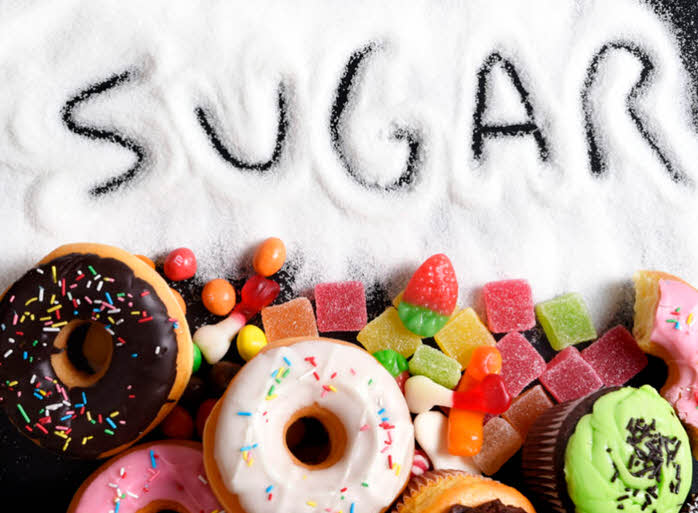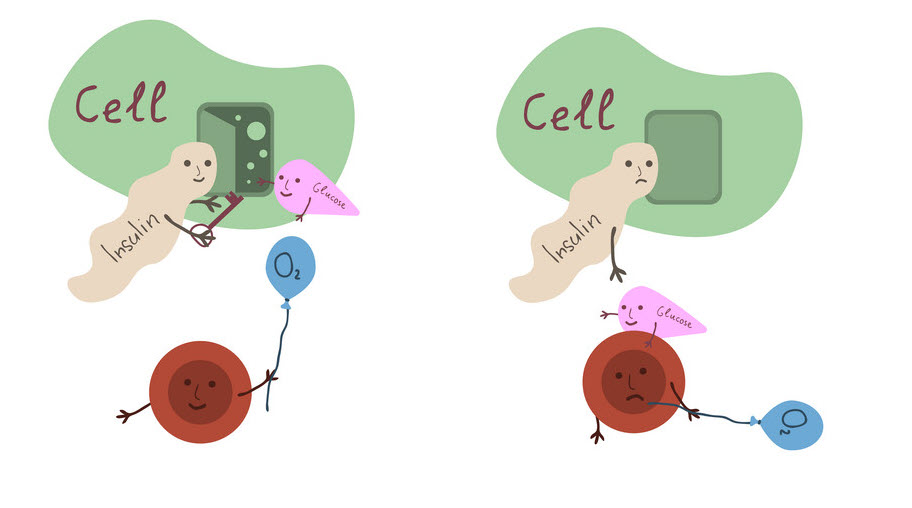Killing Sugar Addiction Before It Kills You
We all know that sugar is terrible for you… yada, yada, yada… But how much do you really know about sugar?
How it works? What it’s used for in the body? Why too much leads to serious disease?
Well, worry not, because today we’re going deep into the world of sugar.
The History of Sugar

Before sugar ruled the world, honey was the bee’s knees, and in places that didn’t have bees, nectars and fruits had to do.
It’s believed that cane sugar was first used in Guinea almost 8000 years ago, then made its way over to China and India.
Then in 510 BC, Emperor Darius of Persia (now Iran), invaded India where he found “a reed which gives honey without bees” (sugar cane).
The secret of sugar cane was kept a closely guarded secret whilst the finished product was exported for trade.
Then when the Arab’s invaded Persia in 642 AD, they found sugar cane being grown and learned how sugar was made.
As Arab expansion continued, they established sugar production in other lands they conquered including North Africa and Spain.
Sugar was only discovered by western Europeans as a result of the Crusades in the 11th century AD.
The first written record of sugar in England was back in 1069.
From there, sugar saw a major expansion through European trade with the East.
At this time, sugar was regarded as a true luxury.
In the 15th century, Columbus sailed to the Americas, and it’s said he took sugar cane plants to grow in the Caribbean. The climate there was so ideal for growing sugar cane that it quickly became a mainstream industry.
From there, the rest is history…
The Evolution of Sugar In Society

What Exactly Is Sugar?
The white stuff we all know today as sugar is actually called sucrose, which is a molecule composed of 12 atoms of carbon, 11 atoms of oxygen, and 22 atoms of hydrogen – (C12011H22).
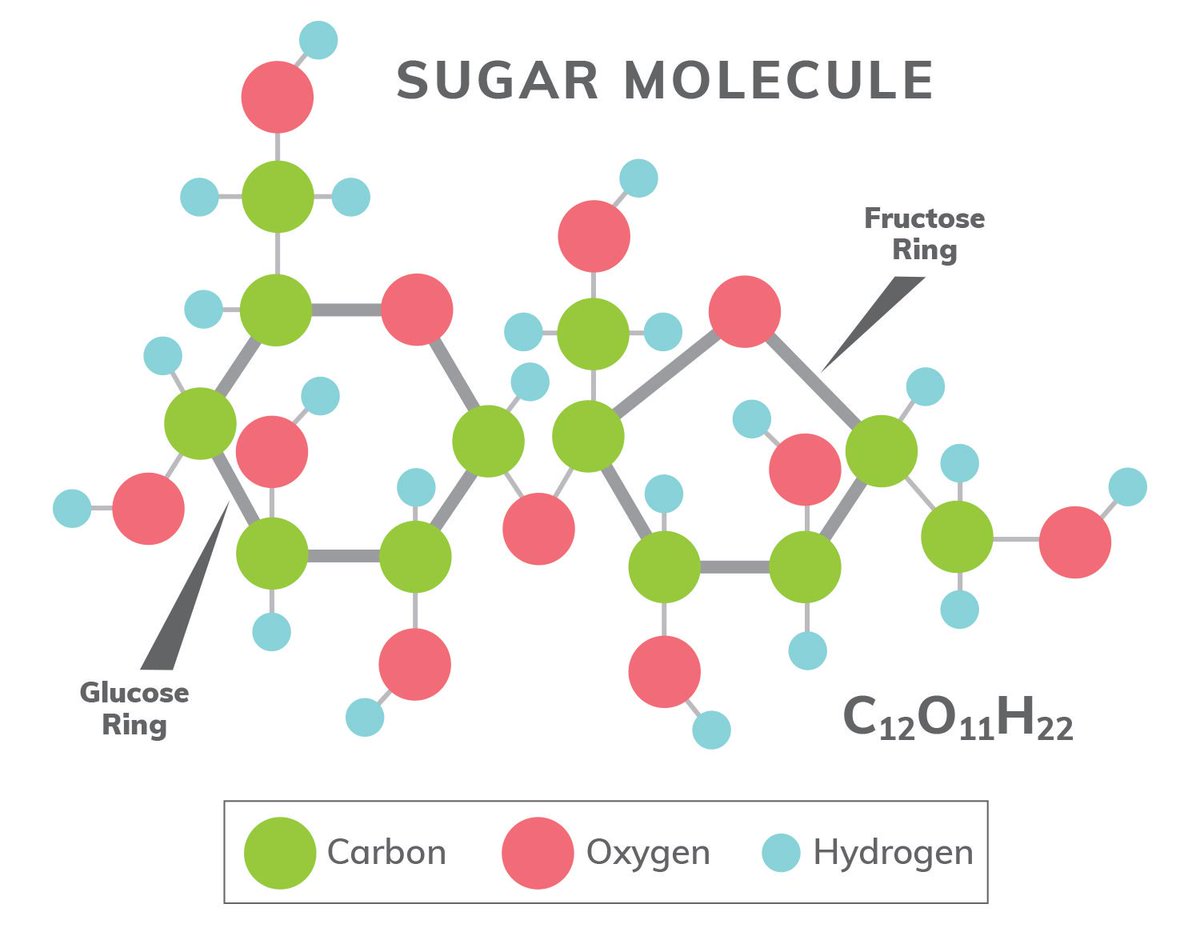
Sugar is made by many types of plants via photosynthesis, which is the process plants use to transform the sun’s energy into food.
Of all the plant types that create sugar, sugar beets and sugar cane have the greatest quantities of sugar, hence why we call it “sugar”.
Sugar Content By Plant Type

The Different Types of Sugar
There are 4 main types of Sugar:
- Sucrose (table sugar).
- Glucose/Fructose (fruit sugar).
- Lactose (dairy sugar).
- Maltose (found in most malted/fermented drinks).

Sugar is a carbohydrate. We classify these carbohydrates as either “simple” or “complex” depending on how difficult it is to turn the carb into usable energy by the body.
Simple Carbohydrates
The most basic units of carbohydrates are called simple carbohydrates.
Simple carbs are typically made with monosaccharides, such as glucose and fructose (fruit sugars).
These simple sugars immediately enter the bloodstream without the need for extra breakdown.
Table sugar is defined as a simple carb. Other sugars like maltose and lactose are called disaccharides.
Your body needs to split disaccharides down into monosaccharides so they can be used for energy.
When it comes to foods, we also break carbohydrate-based foods into simple and complex carbs.
Simple carb foods are easier to break down which can be turned into glucose at a rapid rate.
Examples of Simple Carbs

Complex Carbohydrates
Complex carbs are those made from more complex starches and fiber.
These carbs are made with long chains of glucose molecules, also known as polysaccharides.

It’s much harder for your body to break these long chain structures down. This is actually a good thing as it slows the release of glucose into the blood, which also slows down the insulin response to those sugars, (but more on that later).
Digestive enzymes first have to cut these long chains into smaller pieces, before the body can absorb them.
Complex carbs include things like: wholegrain rice, multigrains, potatoes, corn, and whole wheats. They also include veggies such as pumpkin, carrots, sweet potatoes, and peas.
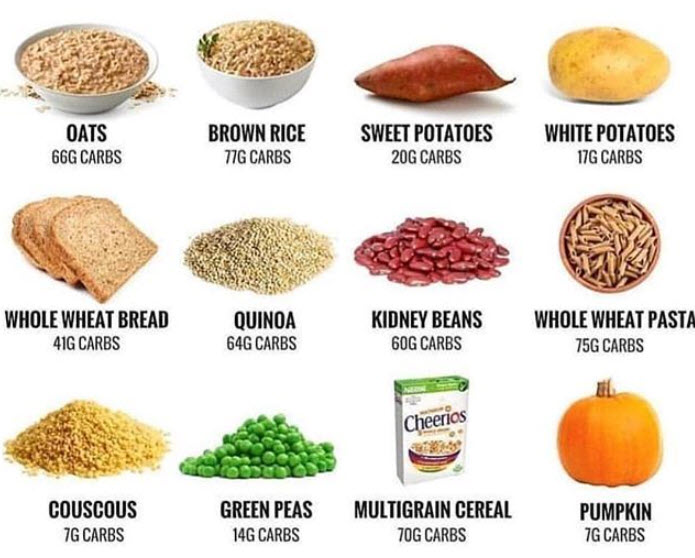
But Today, Sugar Intake Is Out of Control
According to studies our ancestors got 22-40% of their daily caloric intake from carbohydrates, mostly from nutrient-rich plants and fruits (complex carbs).
Nowadays, (in our convenience-driven society), our daily carbohydrate intake is often around 60 to 70% of our total dietary intake. The bulk of these carbs are simple carbs.
As such, a majority of our society has way too much glucose floating around their bloodstreams. This is why diabetes and obesity are at epidemic proportions today.
The amount of sugar we consume today versus 100 years ago has grown by up to 1700% (17x)!
Some Crazy Sugar Stats

Sugar Addiction Is Like Drug Addiction
Sugar is a drug, there’s no doubt about it. It has similar tendencies on people.
In fact, here’s a brain scan of a person on sugar, versus one that’s on cocaine – see any similarities?
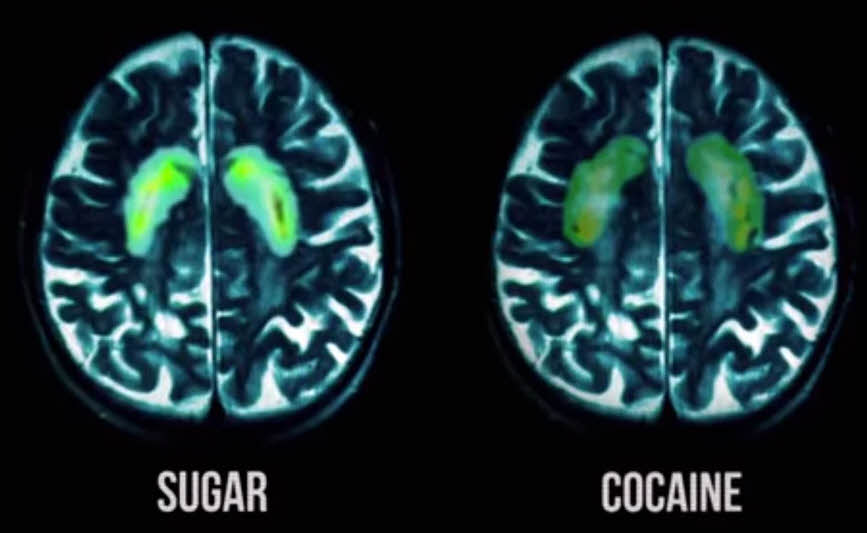
The same nodes in the brain are activated, and the neurotransmitter activity is almost identical to cocaine.
Sugars Are Everywhere Today
Sadly, industrial food producers today know how addictive sugar is, and often add high amounts of simple sugars, such as fructose and glucose to trigger this inherent addiction and ultimately sell more crap.
Sugars In Everyday Foods
Have a look at this infographic below. It shows the amount of sugars found in many everyday foods represented by the number of sugar cubes in it.
Some of them are obvious, but did you know that just 2 tbsp.’s of Jif or Kraft peanut butter have 3 cubes of sugar in it? This is quite common in many foods you would not suspect of having any sugar in it.

What Happens To The Sugar We Eat?
The only real function of sugar is to give your body energy.
When the monosaccharides, disaccharides and polysaccharides are broken down into singular glucose, or fructose molecules, they end up in your bloodstream.
But to transform any sugars into usable body fuel, sugar has to be ‘burnt’ in your cells & that’s where insulin comes in to play.
Insulin Structure

Insulin is actually a hormone, and it functions like a key that unlocks cells in order to get sugar out of the bloodstream and into liver and muscle cells where it can be converted into blocks of usable energy known as ATP.
How Insulin Works
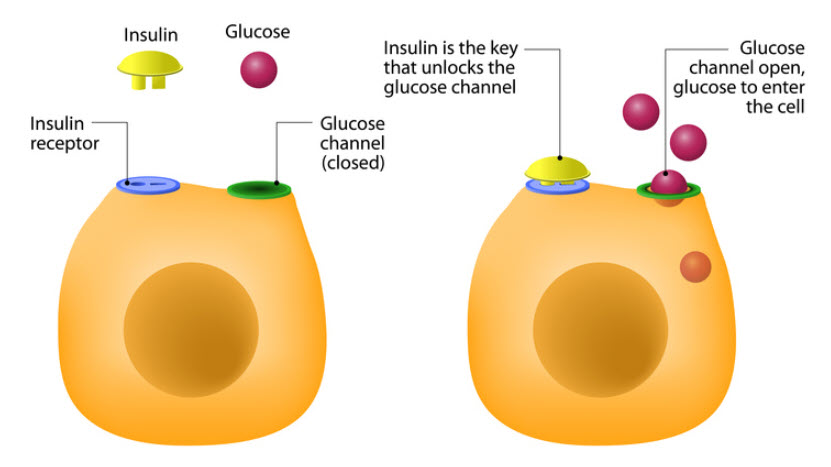
Insulin is produced by the pancreas.
A healthy pancreas produces exactly the right amount of insulin to keep your blood sugar level balanced.
Issues can begin when there is too much sugar in the system, and insulin levels in the blood grow, creating a state of insulin resistance – which is terrible for your health.
What’s Insulin Resistance?
In a nutshell, insulin resistance is when your cells don’t recognize or “see” insulin in the blood.
As a result, your cell’s insulin receptors become unresponsive to insulin and the door that insulin opens is kept shut. As a result, the sugars stay in the blood, and that leads to some pretty dangerous conditions over time.
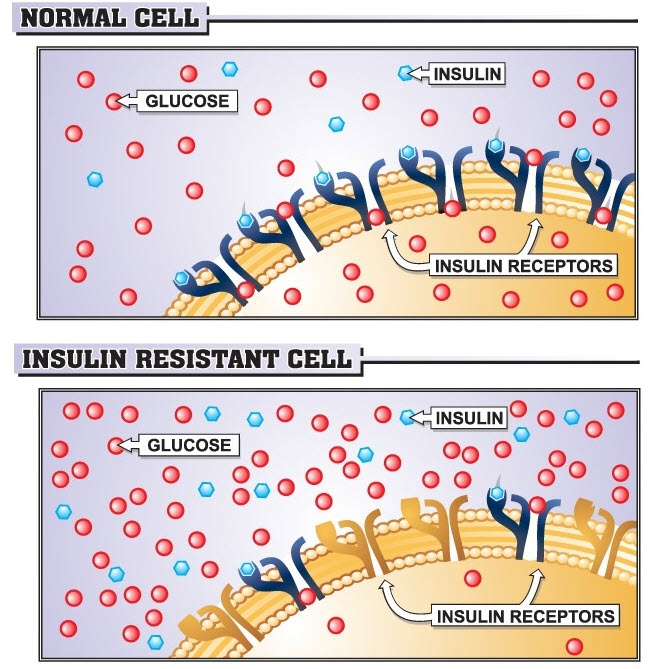
Insulin Resistance is a Serious Health Issue
The Core of Obesity & Diabetes
Every time your blood sugar rises, your insulin-factory (the pancreas) is activated.
When you become insulin resistant, and at a certain point, the body just keeps producing more and more insulin to keep blood sugar in some form of balance.
This insulin overload continues to make your cells more and more insulin resistant; meaning insulin cannot easily bind to the cell any longer, making it harder and harder to get sugar out of your blood and into your cells. It’s truly a VICIOUS CYCLE

When this happens your body will face non-stop sugar cravings, fat storage rapidly increases, and fatigue is ongoing because your cells (ironically) don’t get enough sugar to create energy (ATP).
Eventually, this state of insulin resistance leads to inflammation, obesity, organ damage, diabetes, and much more.

Metabolic Syndrome
Metabolic syndrome is a group of health problems that include too much fat around the waist, elevated blood pressure, high triglycerides, elevated blood sugar, and low HDL cholesterol. Together, this group of health problems increases your risk of heart attack, stroke, and diabetes.
Research has shown a direct relationship between too much insulin, and metabolic syndrome.
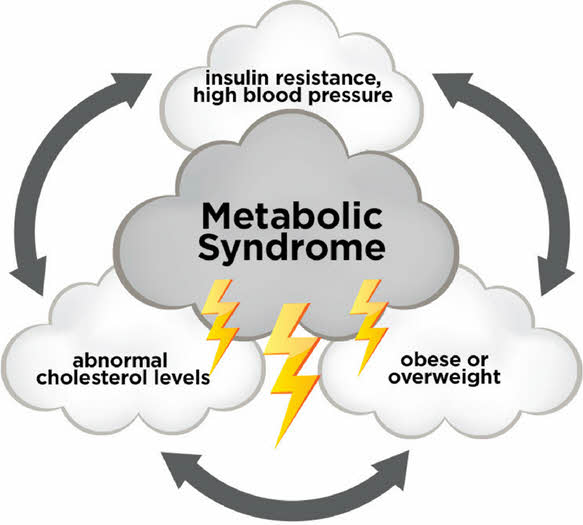
In the long run, insulin resistance becomes a hard-to-reverse metabolic disorder, in which the patient suffers from a combination of diabetes-II, cardiovascular disease, and non-alcoholic fatty liver disease, or other chronic ailments such as Alzheimer’s, certain types of cancer, macular degeneration, and tooth decay. FUN!
How To Limit Sugar Intake

Now that we better understand the negatives of too much sugar in the blood, we can look at some simple strategies to help change these outcomes.
For thousands of years, sweetness was scarce, only available at limited times, in limited amounts and in limited places.
When your ancestors would’ve found a sweetly ripened fruit, they would’ve hit the primal jackpot!
From an evolutionary perspective, sugar is energy that can also be stored as fat. Fat is incredibly useful for survival during food-scarce times such as cold winters.
So our love for sugar is genetically programmed in our bodies. That’s why we can’t help ourselves when it’s around. We need to put it in our mouths! It’s our instinct!
Again, sugar even triggers reward systems in our brains, much like other addictive substances such as alcohol and drugs.
But today sugar is so plentiful, it has become a brutal detriment to our health and is easily one of the leading causes of death in the Western world.
Here’s a couple of things you can do to help easily lower sugar overall intake.
1. Know What You’re Buying
The problem is that sugar no longer comes as a limited edition. It’s everywhere. We eat it all the time.
It’s even tougher today, as we not only battle our genetics, we have to also battle evil corporations that litter our food with sugar.
Even more devious, is that they hide sugar behind other names for sugar that we may miss when looking at a food label. It’s all an evil marketing ploy.
Here’s a list of other common names for sugar that make it sound healthy, but it’s still just plain old sugar when broken down by the body.
There are over 200 names for sugar, here are a few more common ones to know…

If you know more of what to look for on food labels, you can begin to identify hidden sugar, and make better, wiser food choices.
2. Make Simple Swaps & Make More Food At Home
Look, we get it. The thought of giving up sweets can be agonizing, it’s a true addiction.
But hey, why not start swapping some of your simple sugars for more complex carbohydrates?
Remember, sugars are found lurking in a lot of store-bought foods, not just the usual suspects.
So by having a bit more of a plan and making some pretty simple swaps (in theory), you can really impact your sugar intake.
In the end, the “practice” part is the hardest, but that comes down to discipline and desire.
If you want to do something and make a change… You can!
Here are some examples of some simple food and drink swaps that can easily cut 30- 50% + of your daily sugar intake while making food actually more enjoyable!

Bottom Line
Sugar tastes amazing, but even a little extra over time can have very serious impacts. If you don’t want to deal with diabetes, heart disease, inflammation, depression, energy issues… Then get wiser about the food you eat and get serious about making a change. Always remember the right food is truly medicine. There is nothing that beats, pure, whole foods.
End of story 🙂


Sale Details:
⚡ Ending in 72 Hours⚡
Get Up To 45% off on Multi Packs OR Save An Extra 10% Off Any of Our Already Discounted Bundles!
Just Apply Promo Code: 👉 well10👈 at Checkout 🛒
Shop Now


Shop USA Store

All Orders Ship From Our California Warehouse
Shop Canada Store
![]()
All Orders Ship From Our Toronto Warehouse
Happy Body Bundles
Try Different Product Bundles & Save Up To 53% With Free Shipping!

*Note some products are not available in Canada at this time
Shop Bundles USA


Shop Bundles Canada
![]()

Disclaimer: Information presented on this site is of a general nature used for educational and information purposes only. Statements or opinions about products and health conditions have not been evaluated by the US Food and Drug Administration or Health Canada. Products and information stated herein are not intended to diagnose, treat, cure, or prevent any disease or condition. If you have any concerns about your own health or are wanting to use a new mineral supplement, vitamin or herbal supplement, you should always consult with your physician or other healthcare professional first. Do not use information on this site or on our social media pages as a replacement for validated medical information / opinion, or as a basis for self-diagnosis. This is the same for your pet; always consult with your veterinarian before starting your pet on any new pet supplement or vitamin first.
Pricing: For our website and catalog, the Regular (Reg) Price is also referred to as the MSRP is the “Manufacturer’s Suggested Retail Price.” The MSRP is understood to mean the price at which a manufacturer will recommend a retailer or reseller to sell a product for in stores, on the internet, or in catalogs. For Happy Body Store/Happy Body/HappyBody branded items, the MSRP is calculated based on a varying percentage above the product’s completed production price & associated administration, marketing & logistics. Prices can change at any time for any reason. Pricing & sales offers can change at any time without notice, and at our sole discretion.


